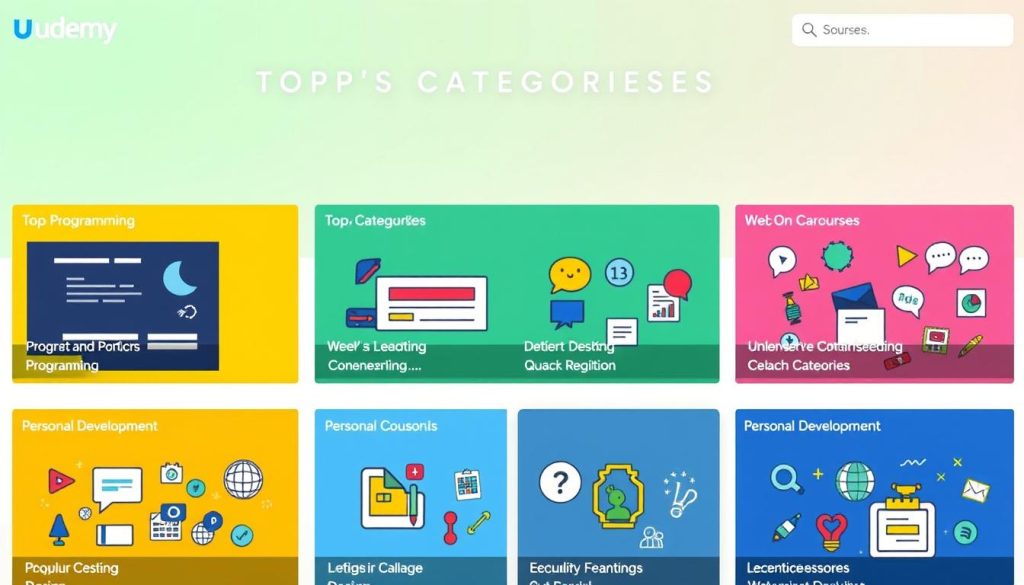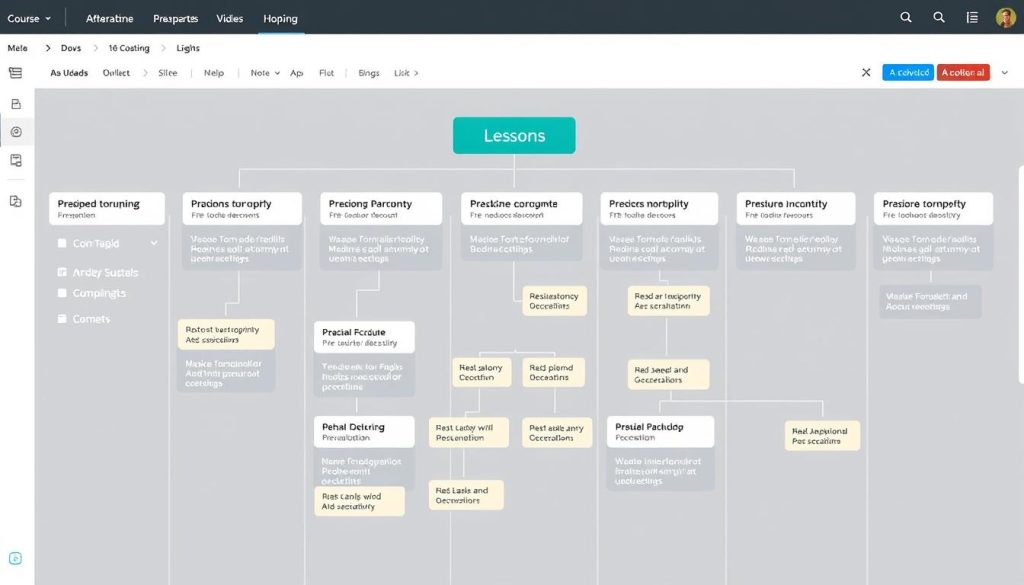Picking the right topic for your Udemy course is crucial for success. I’ve been creating courses for years and learned that teaching what you know isn’t enough; you need to teach what people want to learn.
I made the mistake of creating content without researching demand, and it didn’t work out. The Udemy marketplace has exploded to 77 million users and 260,000+ courses, making it a competitive space.
In this guide, I’ll share my framework for validating course ideas and finding a topic that balances your expertise with market demand. With the rise of online learning and videos, now is the perfect time to create a successful course.
Key Takeaways
- Understand the importance of picking the right topic for your course
- Learn how to validate your course idea
- Discover how to balance your expertise with market demand
- Get a clear roadmap for finding your perfect course topic
- Understand the current online learning landscape
Understanding the Udemy Marketplace
Understanding the dynamics of the Udemy marketplace is key to creating a successful course. This will help you make informed decisions about your course topic.
Udemy’s Growth and Current Position
Udemy has experienced significant growth, with its courses gathering more than 830 million enrollments. Despite recent challenges, such as layoffs and declining instructor payouts, Udemy remains a dominant player in the self-paced online learning space. Between 2022 and early 2024, its stock price remained relatively constant, but it has since declined somewhat. The platform’s resilience is evident in its vast user base and extensive course offerings.

The 80/20 Rule of Udemy Success
Udemy’s marketplace follows the classic 80/20 rule, where the top 20% of courses account for a significant majority of enrollments – a whopping 91%. This means your goal should be to position your course within the top 20% to achieve substantial success. The data reveals that while there are 904 courses with over 100K enrollments, the median enrollment for all classes is only 208, highlighting the competitive nature of the platform.
What Makes a “Winning” Course Topic
A “winning” course topic isn’t just about being popular; it’s about solving a specific problem, delivering tangible results, and having enough demand without being oversaturated with competition. The most successful instructors don’t just teach what they’re passionate about; they find the sweet spot where their expertise overlaps with what people are actively searching for and willing to pay to learn. Understanding Udemy’s algorithm and promotion system is also crucial, as it favours courses that demonstrate early engagement and completion rates.
- Udemy’s top 20% of courses account for 91% of all enrollments, making it crucial to position your course in this bracket.
- A successful course topic must solve a specific problem and have sufficient demand without excessive competition.
- Understanding Udemy’s algorithm is key to creating a successful course, as it favours early engagement and completion rates.
Top-Performing Udemy Course Categories

After analysing top Udemy courses, it’s clear that specific categories stand out from the rest in popularity and profitability. The data from 250 top courses shows enrollments ranging from 216K to 2M, with 10 courses having over 1M enrollments. These top courses primarily focus on tech and business skills, indicating a strong demand for these areas.
Programming and Development
Programming and development courses are among the most popular on Udemy. Python courses, in particular, have seen massive success, with titles like “The Complete Python Bootcamp From Zero to Hero in Python” achieving over 1M enrollments. Other successful courses include Java tutorials and full-stack web development boot camps. The key to their success lies in their ability to promise and deliver transformation, turning beginners into proficient developers.
Business and Entrepreneurship
Business and entrepreneurship courses also perform exceptionally well on Udemy. Courses teaching practical skills like Microsoft Excel, digital marketing, and financial analysis are highly sought after due to their clear ROI for learners. These courses help professionals enhance their career prospects and businesses improve their operations.
Data Science and Machine Learning
Data science and machine learning courses are gold mines on Udemy. Titles like “Machine Learning A-Z: AI, Python & R + ChatGPT Prize [2025]” have attracted hundreds of thousands of students. These courses cater to the growing demand for data-driven decision-making and AI skills in the job market.
Design and Creative Skills
While design and creative skills courses may not always hit the 1 M+ enrollment mark, they have extremely loyal audiences and less competition than programming courses. Courses on Adobe Photoshop, drawing, and web design are popular among those looking to enhance their creative skills. These niches offer opportunities for instructors to build dedicated followings.
Across these categories, successful courses share a common trait: they promise and deliver transformation. Whether it’s going from “zero to hero” in Python or becoming a “complete” web developer, the most successful courses offer clear, tangible outcomes that attract learners.
Analysing the Most Successful Udemy Courses
When diving into the world of Udemy, it’s fascinating to analyse what makes the most successful courses tick. With thousands of courses available, understanding the factors contributing to a course’s success can be incredibly valuable for instructors looking to create top-performing courses.
Enrollment Numbers and Patterns
Udemy’s marketplace is vast, with 904 courses having over 100,000 enrollments and 10 courses boasting over a million enrollments. Analysing the top 250 courses on Udemy, sorted by enrollment numbers, reveals some intriguing patterns. The top courses include titles like “The Complete Python Bootcamp From Zero to Hero in Python” and “Java Tutorial for Complete Beginners.”
Upon closer inspection, it becomes clear that courses with “Complete” or “Bootcamp” in their titles tend to outperform others. This suggests that students are drawn to comprehensive learning experiences that promise to take them from beginner to advanced levels.
| Course Title | Enrollment Numbers | Course Length (hours) |
|---|---|---|
| The Complete Python Bootcamp | 1,000,000+ | 30+ |
| Java Tutorial for Complete Beginners | 500,000+ | 20+ |
| Microsoft Excel – Excel from Beginner to Advanced | 400,000+ | 15+ |
Common Characteristics of Million-Enrollment Courses
The million-enrollment courses share several key characteristics. Firstly, they often target beginners or promise to take students from beginner to advanced levels, tapping into a larger market. Secondly, these courses tend to be quite substantial, with 30+ hours of content, contradicting the myth that shorter courses sell better.
- Frequently updated courses (often yearly) to stay current tend to perform better.
- Certification-focused courses, like those for AWS or Python, perform exceptionally well due to their clear, tangible outcomes.
- Successful instructors package their skills into career-focused learning paths, helping students visualise their transformation after completing the course.
By understanding these patterns and characteristics, instructors can create courses more likely to succeed on the Udemy platform.

Finding Your Udemy Course Niche
Becoming a top Udemy instructor begins with finding a niche that aligns with your passion and market demand. With over 260K courses available on Udemy, the platform offers vast opportunities for creators. However, this also means that standing out requires a strategic approach to niche selection.

Balancing Passion with Market Demand
One of my biggest mistakes with my first course was teaching a topic I loved but nobody was searching for. Now, I always validate demand before investing time in course creation. The sweet spot is where your genuine expertise and passion intersect with proven market demand, ensuring you can create authentic content that sells.
Identifying Underserved Sub-Niches
One effective strategy is looking for “gap topics” or subjects between two popular categories. For instance, “Python for Financial Analysis” combines programming with business skills, offering a unique selling proposition. Targeting specific sub-niches or beginner-friendly angles can be profitable even in saturated areas like Python or data science.
Competitive Analysis Techniques
When researching potential course topics, it’s crucial to analyse the top 5 competing courses. Look at their student numbers, reviews (especially negative ones), and what subtopics they might be missing. Checking how recently top courses were updated is also vital; if leading courses in a niche haven’t been updated in 2+ years, it’s a massive opportunity to create something more current.
To further refine your niche, consider the intersection of trending topics, such as machine learning for healthcare or project management for remote teams. Evaluating potential course topics beyond enrollment numbers to engagement metrics can also indicate genuine interest and need.
Validating Your Course Topic Ideas
Validating your course topic is a critical step that can make or break its success on Udemy. I’ve learned this through personal experience, and it’s a lesson that can save you time and resources in the long run.
Before we dive into the specifics, let’s understand that validation is about ensuring there’s a demand for your course topic and that you can deliver something unique and valuable to potential students.
Keyword Research Methods
Conducting thorough keyword research is one of the first steps in validating your course topic. Tools like Ubersuggest or Ahrefs can provide insights into what potential students are searching for online. For instance, if you’re planning a course on Python programming, these tools can help you understand the search volume and competition around keywords like “Python for beginners” or “Python programming tutorials.”
By analysing keyword trends and search volumes, you can gauge the interest in your topic and identify gaps in existing content that your course can fill.
Testing Market Interest
Another effective way to validate your course topic is by testing market interest. This can be done by creating a simple landing page or a YouTube video on your subject and measuring the response. If you’re considering a course on data science, for example, a video introduction to data science concepts can help you gauge interest and gather feedback from viewers.
This approach validates your topic and helps you understand your audience’s needs and preferences.
Analysing Competitor Reviews for Gaps
Analysing reviews of competing courses on Udemy can provide valuable insights into what’s missing in the market. By paying special attention to negative reviews, you can identify gaps in existing courses that your course can address. For instance, if several reviews mention that a course lacks practical exercises, you can focus on including comprehensive, hands-on projects in your course.
| Validation Method | Description | Tools/Resources |
|---|---|---|
| Keyword Research | Analyse search volume and trends | Ubersuggest, Ahrefs |
| Testing Market Interest | Create a landing page or YouTube video | Landing page builders, YouTube |
| Competitor Review Analysis | Identify gaps in existing courses | Udemy course reviews |
By following these validation methods, you can ensure that your Udemy course topic is not only viable but also has the potential to stand out in a crowded market.
Structuring Your Udemy Course for Maximum Appeal
A well-structured Udemy course can be the difference between a completed course and an abandoned one. When creating your course, you must consider how to keep your students engaged from start to finish.

Creating a Compelling Course Title
Your course title is the first thing potential students see, so it needs to be compelling. Successful titles often include specific outcomes, timeframes, or skill levels, like “Complete Python Bootcamp: From Zero to Hero.” This clarity helps attract the right students.
Using relevant keywords in your title can also improve visibility in Udemy’s search results. For instance, including terms like “Python” or “data science” can help your course appear in searches related to those topics.
Designing an Engaging Curriculum
When designing your curriculum, start with a logical progression that delivers quick wins early on. This keeps students engaged and builds their confidence. I recommend creating clear sections that each produce a specific skill or outcome, making it easier for students to track their progress.
Incorporating hands-on projects and real-world applications is also crucial. This practical approach helps abstract concepts stick, as students see how the code or techniques they learn solve problems.
Incorporating Projects and Practical Applications
The most engaging courses include hands-on projects students can add to their portfolios. This not only keeps students engaged but also provides them with tangible outcomes they can showcase. An “apprenticeship-style” teaching approach, where you demonstrate code or techniques and then have students practice, works particularly well for technical topics.
Including downloadable resources, cheat sheets, and solution files enhances the learning experience. These resources allow students to reference the material long after completing the videos, reinforcing their learning.
Timing and Trends in Udemy Course Topics
As I’ve navigated the world of creating Udemy courses, I’ve realised that timing is everything. The key to a successful Udemy course is understanding the perfect timing and trends. Whether creating a course on a trending topic or an evergreen subject, being aware of the market demand and seasonal fluctuations can make all the difference.
Evergreen vs. Trending Topics
Through my experience, I’ve learned that evergreen and trending topics have pros and cons. Trending topics like ChatGPT or new frameworks can generate huge initial sales but require constant updates to stay relevant. On the other hand, evergreen topics like Python fundamentals sell consistently for years. The ideal approach is to create courses on evergreen topics while incorporating trending elements.
- Teaching fundamental machine learning concepts using the latest neural network architectures as examples.
- Creating courses that combine timeless skills with modern applications.
Seasonal Considerations for Course Launch
Timing your course launch strategically can dramatically impact your initial success. Based on my observations, the best times to launch a course are January (New Year’s resolutions), September (back to school), and late November (Black Friday sales). Additionally, certification-related courses tend to see predictable spikes in demand around exam update cycles.
| Launch Time | Target Audience | Course Type |
|---|---|---|
| January | Professionals seeking New Year’s resolutions | Career development, project management |
| September | Students and professionals looking for back-to-school resources | Academic subjects, data science |
| Late November | Shoppers looking for Black Friday deals | Discounted courses on various topics |
Understanding these trends and timing your course launch accordingly can significantly boost your chances of success on Udemy. Knowing the market and seasonal fluctuations is crucial for teaching code, machine learning, or other in-demand skills.
Case Studies: From Zero to Successful Udemy Instructor
The stories of successful Udemy instructors offer valuable lessons for those looking to make their mark on the platform. By examining the journeys of top performers, we can identify key strategies that contribute to their success.
Success Story: Programming Course Creator
Alex, a developer, went from zero to over $10,000 in monthly Udemy income with his Python programming courses. His key insight was creating a learning path of multiple connected courses rather than a single massive course. By focusing on project-based courses where students built actual working applications, Alex was able to differentiate his offerings in a crowded market.
Alex’s success came from identifying a gap in the market for Python courses that focused on real-world applications. His courses helped students build portfolio-worthy projects, making them more attractive to potential employers.
Success Story: Business Skills Instructor
Sarah, who leveraged her corporate business experience, created practical business skills courses. Her breakthrough came when she realised most business courses were too theoretical, so she focused entirely on actionable templates and frameworks. Sarah’s courses stand out because they incorporate real-world case studies and provide downloadable resources like Excel templates that students can immediately apply to their work.
By making her courses highly relevant and practical, Sarah was able to attract a large following on Udemy.
Key Takeaways from Top Performers
The common thread among successful instructors is their commitment to student success. They actively participate in Q&A, update courses regularly, and build communities around their teaching. Top performers also use free courses or YouTube videos as lead generators, creating short, high-quality content that funnels students toward their premium courses.
To achieve similar success, instructors should focus on building ecosystems with complementary courses, communities, websites, and practice exercises. By doing so, they can create a loyal following and increase their earnings on the platform.
Conclusion
As we conclude this journey through the Udemy landscape, it’s clear that the right strategy can make all the difference. When I look back at my journey from a struggling instructor to a consistent course creator, the turning point was when I stopped guessing what would sell and started researching actual market demand.
The most important lesson I’ve learned is that successful Udemy courses sit at the intersection of three things: your genuine expertise, proven market demand, and a unique angle that differentiates you from competitors. This isn’t just about choosing a popular topic; it’s about creating a course that delivers tangible results for students.
Remember, the Udemy marketplace follows the 80/20 rule on steroids, with the top 20% of courses getting 91% of all enrollments. So, your goal should be positioning your course to break into that top tier. Technical topics like programming, data science, and machine learning consistently dominate the platform, but don’t let that discourage you if your expertise lies elsewhere – every category has its successful outliers.
The validation process I’ve outlined might seem time-consuming, but it’s far less painful than spending months creating a course nobody wants. By structuring your course for maximum engagement – with early wins, practical projects, and a clear learning path – you’ll be well on your way to success.
I encourage you to take action today. Start researching potential topics using the methods I’ve shared, and you might be surprised to discover the perfect course idea hiding at the intersection of what you know and what the market wants.





























Add comment